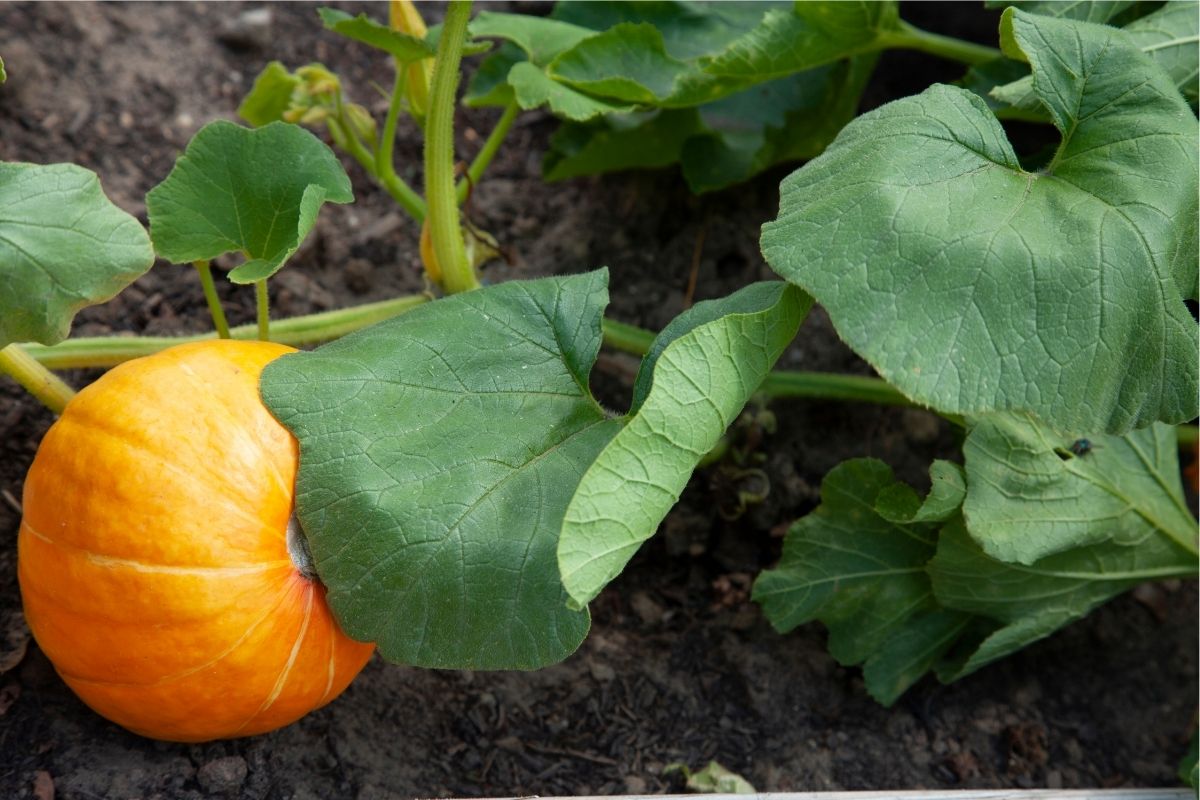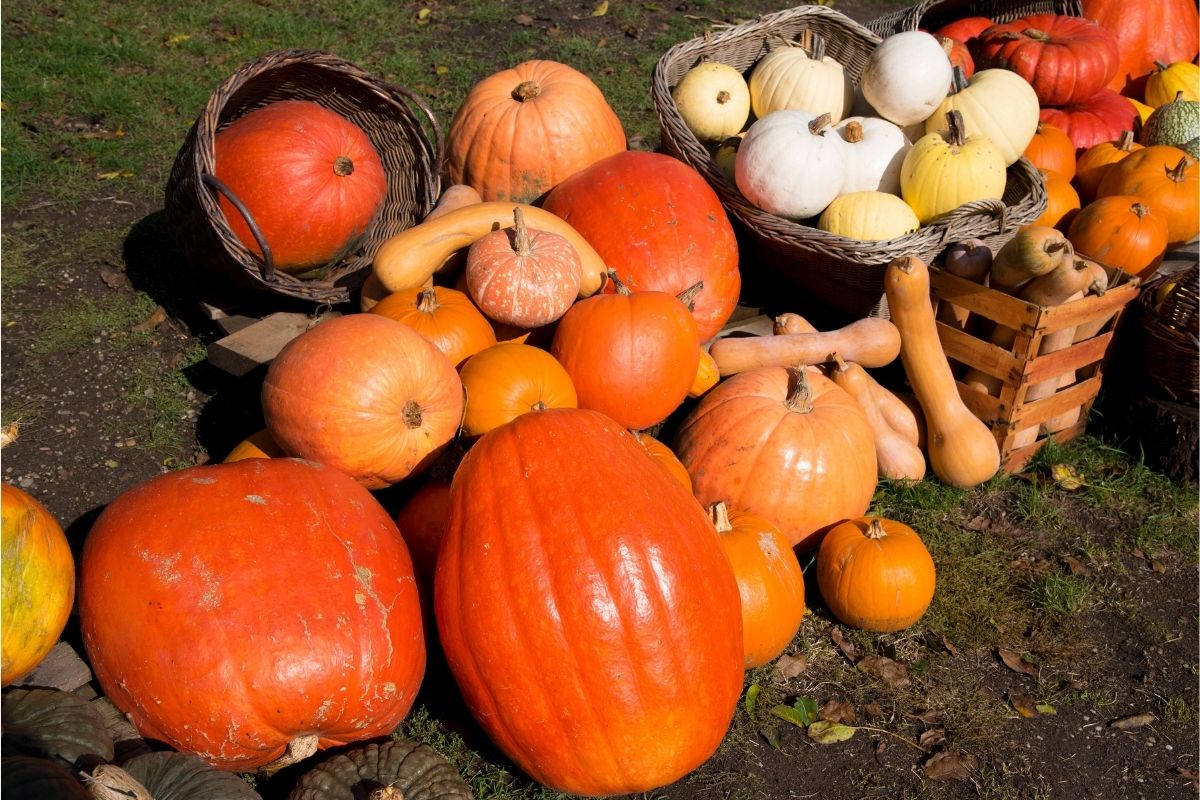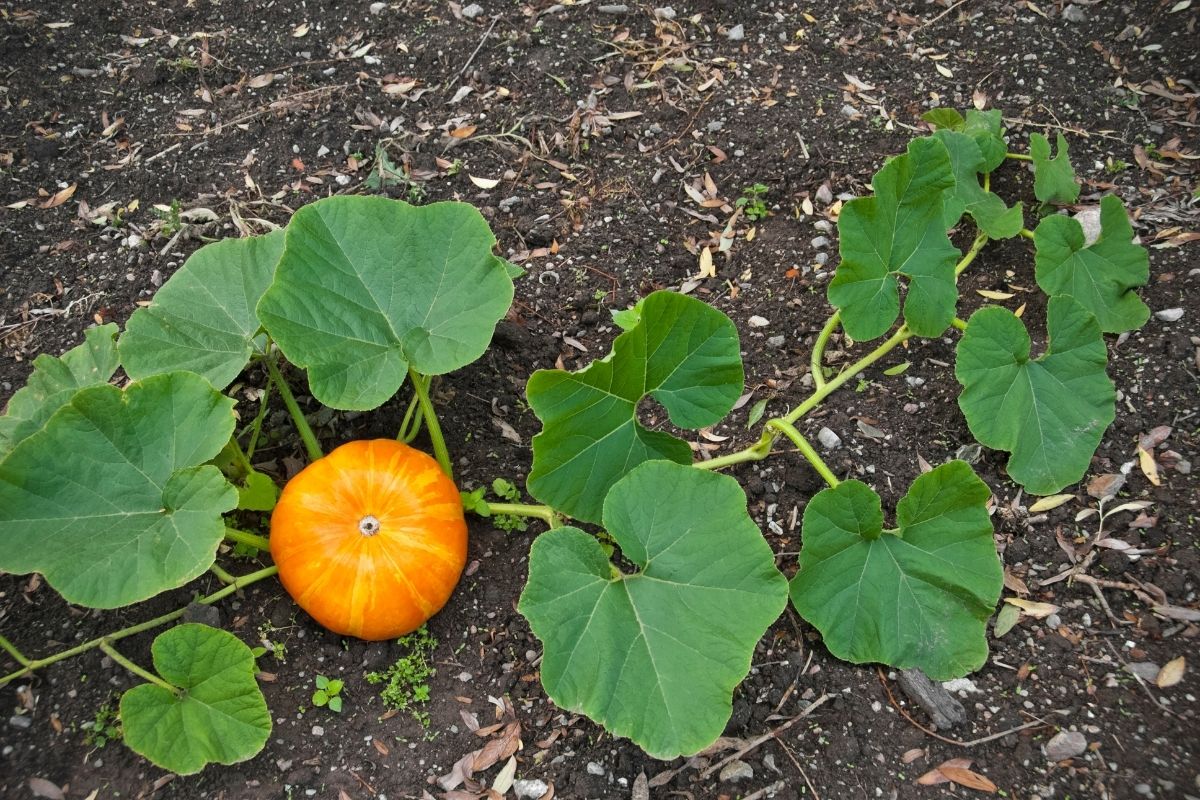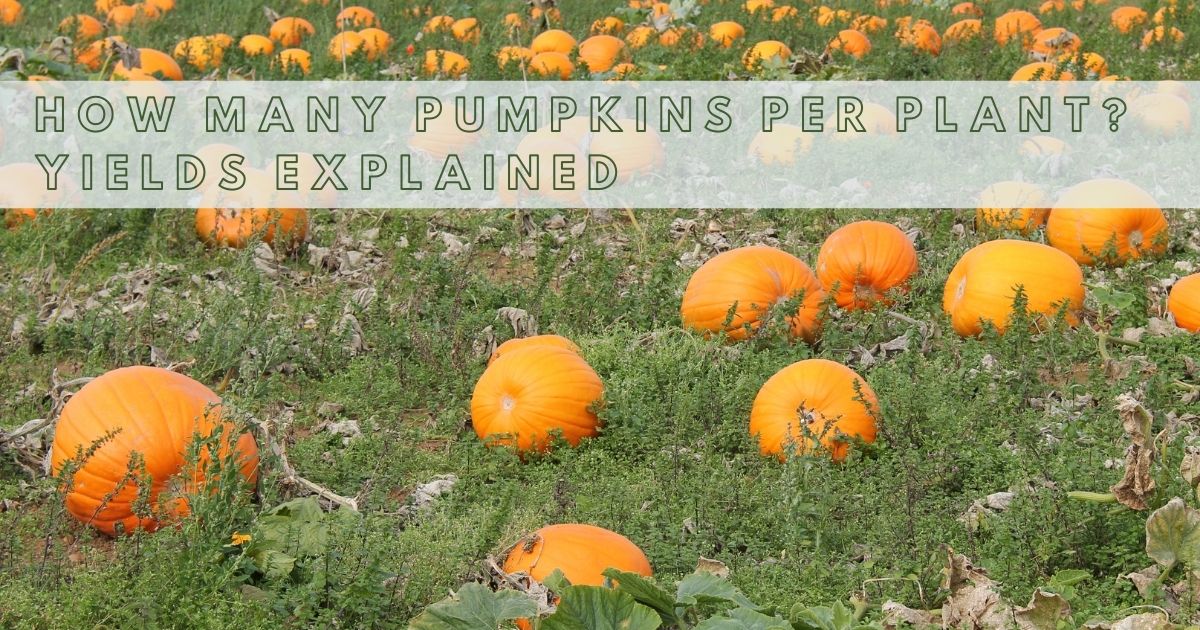What Does a Pumpkin Plant Look Like?
What is the yield of a single plant in terms of pumpkins? How many pumpkins per plant do they produce? The typical pumpkin plant can have two to five pumpkins, although the smaller variety can produce up to 12 pumpkins per plant. As the pumpkin grows, vines sprout vivid yellow blossoms in the middle of the growing season.

When to Plant Pumpkins
Insensitive to the cold are pumpkins. Avoid direct seeding until the risk of frost passes and the soil temperature is between 65 and 95 degrees Fahrenheit (18.33 and 35 degrees Celsius). In five to ten days, seedlings should appear in the soil. This occurs in late May in colder climates. The first planting date is available on our calendar.
Check the seed packaging for the number of days to harvest if you want pumpkins for Halloween. Work backward about a week before Halloween to determine when to plant the seeds. Start by sowing indoors in peat pots two to four weeks before the final spring frost if the growing season is quite short.
How to Care for Pumpkins
Now that you have planted your pumpkins properly, it’s time to concentrate on the usual care to help you keep your plants and pumpkins healthy:
provide a lot of water
Provide a Lot of Water
Give your pumpkins plenty of water each week, aiming for around 1 inch (2.5 centimeters). Don’t let your routine slip; watering regularly is especially important during the hot summer months.
Water the soil only but not the plant’s stems or leaves. You should apply water to the pumpkin roots rather than the leaves since wet leaves are a breeding ground for pests and diseases.
Offer Sufficient Nutrition
Your pumpkin plants require your assistance in the form of fertilizer around once a month after you notice those first flowers because they are working hard to create those substantial fruits. This organic plant magic formulation is a fantastic all-purpose choice. Other wonderful options are compost or well-rotted manure.
To cultivate the biggest, healthiest fruits, some individuals choose to fertilize a little more strategically during the growing season: Nitrogen for young plants to help them develop a lot of leaves and phosphorus when the plant is in bloom. Once your pumpkins begin to grow, add potassium and phosphorus.
Remove Extra Foliage by Pruning
Pruning pumpkin vines will reduce space requirements and focus the plant’s energy on the fruit, where it belongs.
Steer Clear of Harsh Chemicals
Use pesticides sparingly because they can harm pollinating bees as well as pests.
Instead, avoiding wet soil, applying fertilizer correctly, and making sure there is enough sunlight can all aid in organically preventing and managing pests.
Use Mulch
Mulching your pumpkin plant can help keep weeds under control, moisture in the soil, and ward off pests. Compost can be an excellent mulching material in this situation. Compost will help feed your perpetually ravenous pumpkin plant and serve as protective mulch.
Support the Fruits
You should elevate your developing pumpkins slightly off the soil by placing them on cardboard, wood, or even some cloth, helping prevent excessive moisture buildup and decay. While you can start doing this as soon as you notice fruits developing, it won’t be crucial until the pumpkins begin to put on significant weight, usually in the middle of July or later.
Carefully Turn the Pumpkin
This one is more about appearance than anything else. Still, appearance is crucial if you plan to use your pumpkins as decorations. Turn your developing pumpkin on the vine gently every few days to avoid a flat side.
Flip it a small amount at a time, taking care not to twist it too much and harm the stem. If you stick to your particular rotating procedure, you should have a lovely, spherical pumpkin.
How Many Pumpkins Per Plant Can I Expect?
Pumpkin Production Rates by Size Category
The single biggest factor affecting how many pumpkins you’ll receive per plant is the size of the pumpkin. Pumpkins are big fruits that require a lot of energy for a plant to produce, even for the tiniest variety. They are, after all, much bigger than, say, a green bean or bell pepper. Here is a thorough division of pumpkin production by size:
Miniature Pumpkins
The normal weight range for mini pumpkins, like Jack Be Little, is between 0.5 and 2 pounds (0.23 and 0.9 kilograms). You can expect to get up to 12 little pumpkins on one plant. They come in three colors: blazing orange, creamy yellow, and white, and they grow on creeping or climbing vines.
Small Pumpkins
Small pumpkins in many sizes, including pie pumpkins and micro pumpkins.
Small pumpkins usually weigh between 3 and 5 pounds (1.4 and 2.3 kilograms) each. From a typical plant, expect to collect 8 to 10 tiny pumpkins.
Medium Pumpkins
You should expect three and six medium-sized pumpkins from each medium-type pumpkin plant. Medium-sized pumpkins typically weigh between 6 and 20 pounds (2.7 and 9.1 kilograms). Lumina and Jarrahdale are two pumpkins in the middle of the size range.
Large Pumpkins
The typical jack-o-lantern variations of large pumpkins often weigh between 15 and 30 pounds (6.8 and 13.6 kilograms). Howden is a good illustration of a big carving pumpkin. However, you can also include the gorgeous heirloom Cinderella pumpkin in this size class.
Jumbo Pumpkins
Many refer to anything larger than a typical large pumpkin as a jumbo pumpkin, although weight varies substantially. Jumbo pumpkins can weigh anything from 50 to over 2,000 pounds (22.7 to over 907.2 kilograms) when you grow them to a huge size.
When to Harvest Pumpkins
What is the time required to cultivate a pumpkin from seed to harvest? A typical pumpkin grows from germination to harvest in roughly 100 days. To explain it in more detail:
- Mini pumpkins take 90-100 days
- Standard pumpkins between 100 and 120 days
- The giant varieties take upwards of 130-160 days
They should mature before the first frost in your area if you plant them in warm soil after the last frost. If not, take precautions against freezing weather to keep the plants and pumpkins from hardening and decaying on the vine. You can make use of blankets, sheets, and even cardboard boxes.

How Long Do Pumpkins Take to Grow?
Depending on the variety, pumpkins typically mature after planting for 90 to 120 days. You should consider a completely colored pumpkin with a hard rind and woody stem mature.
When is Pumpkin Season?
The harvest of pumpkins often takes place in late September or early October. Only during the warmer months are pumpkins cultivated and picked before the first frost. Most gardeners bring their pumpkins inside before the evening lows fall below 40 degrees Fahrenheit (5 degrees Celsius).
The Pumpkin Growing Process Explained
The following are stages that will guide you on how to grow pumpkins.
Sowing the Seeds
Pumpkin seeds have an oval form, are flat, and are a light tint. You can buy some unique pumpkin seedlings in your yard, but I like to save a few seeds from our favorite pumpkin kinds to grow. About two weeks following the final frost of the season, you can sow pumpkin seeds immediately in the garden.
You can also plant your pumpkin seeds indoors if you have a short growing season. At the start of spring, sow the seeds in a seed starting tray and set the tray on a heating mat if the weather is still chilly.
Germination
Pumpkin seeds germinated for 8 to 10 days, but it could take longer if the soil is chilly. The seed shell still has a link to the leaf tips. Oval-shaped seed leaves, sometimes called cotyledons, are the first two leaves that emerge. The first genuine leaves will start a week later.
The Vine’s Development
Pumpkin vines stretch out from the plant’s base and, with enough sunlight and water, can grow as much as six inches (15 centimeters) per day. Depending on who plants the cultivar, the vine can grow to 10 to 20 feet (3 to 6 meters).
When watering, ensure the soil is moist, but keep the leaves as dry as possible to prevent fungus diseases. You might need to water your pumpkin plants once every two days or so while it’s scorching outside.
Development of the Flower
After planting, the pumpkin blossoms will begin to bloom 8 to 10 weeks later. The huge, bright yellow flowers have a long stamen in the center. The female flowers start to bloom about ten days after the male flowers. You can now begin feeding your plants a liquid plant meal every two weeks for an abundant crop.
Pollination
Bees like the pollen and nectar that male pumpkin blossoms produce. The bees travel to the female flowers after visiting the male flowers when there is some pollen and pollination is complete.
Suppose there aren’t many bees in your region. In that case, you can manually pollinate the flowers by applying some pollen from the male blossoms to the female flowers with a little paintbrush. The plant will start to produce fruit once the pollination process is complete.
Fruit Development
You’ll notice tiny round green fruits when the female flowers close at the base of the bloom. These baby pumpkins will quickly grow in size over the coming weeks.
To support the weight of the pumpkin as it grows, if you are growing them on a trellis, make a hammock out of an old t-shirt or pair of pantyhose. After pollination is complete, the pumpkin typically grows to its full size in 45 to 55 days.
Harvesting
The pumpkins are ready for harvesting when the vine begins to turn brown and wither. By tapping on the outside of the pumpkin, you may also determine when a pumpkin is ripe. The time has come to pick your pumpkins if you hear a hollow sound.
Cut the vine using a sharp knife, leaving each pumpkin’s stem connected for at least 3 inches (7 centimeters).
Curing
To cure, you must put the pumpkins outside in a sunny area for about two weeks after harvesting. The pumpkins’ skin becomes harder during curing, extending their shelf life. You must relocate the pumpkins to a covered place to finish curing if you expect rains or frost.
Storage
If properly preserved, pumpkins can stay fresh for at least six months. Put the pumpkins in a single layer in a cold, dark area so air can move between them. Every week, check the pumpkins and throw away any that have mold growth.
So those are the several pumpkin growth stages you might anticipate observing in your garden. Growing your pumpkins is quite rewarding, and watching the pumpkin life cycle is fascinating.
How Many Pumpkins Should You Target Per Plant?
Your intention for the harvest ultimately determines the solution to this issue. Are you interested in growing a large pumpkin like Dill’s Atlantic Giant Pumpkin? Then adjust the plant’s environment so that one pumpkin receives all of the resources (nutrition, sunlight, water), rather than several pumpkins vying for growth.
Aim for at least two pumpkins per plant if you want to grow regular to larger-sized pumpkins, such as the well-known Cinderella Pumpkins.
The Importance of Row Spacing
The row spacing will significantly influence the success of your pumpkin harvest. The key to a great yield, according to many gardeners, is uniform spacing, although this is not always the case. Even if the plants are close, there needs to be plenty of space for them to expand.
There isn’t a single recipe that guarantees the exact growth of your pumpkins. Gardening is a very individualized activity that takes a lot of trial and error before you can produce the ideal crop. The secret is to draw lessons from the past.

The Bottom Line
The appropriate growing conditions can make growing pumpkins quite simple and profitable. This plant is excellent for preparing pumpkin soup, creating pumpkin pies, or adorning your front porch for Halloween. We would appreciate it if you share this post with your friends on social media if you find it useful so they may prepare for their pumpkin plants.
